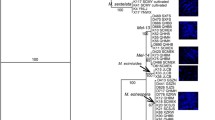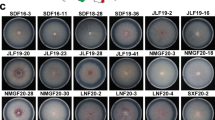Abstract
Fungus strains designated asFusarium sambucinum, F. torulosum, orFusarium sp. nov. were crossed withMAT1-1 andMAT1–2 tester strains ofGibberella pulicaris. Of the 40 field strains that were crossed with the tester strains, 13 strains produced fertile crosses and 27 strains did not produce fertile crosses. One strain designated asF. torulosum was fertile with a tester strain ofG. pulicaris, suggesting that this is an intraspecies cross and that the strain isG. pulicaris, and, consequently,F. sambucinum rather thanF. torulosum. The lack of fertile crosses between tester strains and 27 of the 40 field strains suggests that these strains are notG. pulicaris. Although the ability to form a fully fertile cross with a tester strain can determine the species of a fertile strain, it is more problematic to exclude a strain only because it is infertile.
Similar content being viewed by others
References
Booth C. The genusFusarium. Kew (Surrey, UK): Commonwealth Mycological Institute, 1971, 237 pp.
Nelson PE, Toussoun TA, Marasas WFO.Fusarium species: An illustrated manual for identification. University Park, PA: The Pennsylvania State University Press, 1983, 193 pp.
Gordon WL. Sex and mating types in relation to the production of perithecia by certain species ofFusarium. Proc Can Phytopathol Soc 1961; 28: 11.
Desjardins AE, Beremand MN. A genetic system for trichothecene toxin production inGibberella pulicaris (Fusarium sambucinum). Phytopathology 1987; 77: 678–83.
Beremand MN. Genetic and mutational tools for investigating the genetics and molecular biology of trichothecene production inGibberella pulicaris (Fusarium sambucinum). Mycopathologia 1989; 107: 67–74.
Marasas WFO, Nelson PE, Toussoun TA. ToxigenicFusarium species: Identity and mycotoxicology. University Park, PA: Pennsylvania State University Press, 1984, 328 pp.
Beremand MN, Desjardins AE, Hohn TM, Van Middlesworth F. A survey ofFusarium sambucinum (Gibberella pulicaris) for mating type, trichothecene production and selected traits. Phytopathology 1991; 81: 1452–1458.
Yoder OC, Valent B, Chumley F. Genetic nomenclature for plant pathogenic fungi. Phytopathology 1986; 76: 383–385.
Desjardins AE, Gardner HW. Virulence ofGibberella pulicaris on potato tuber and its relationship to a gene for rishitin metabolism. Phytopathology 1991; 81: 429–435.
Author information
Authors and Affiliations
Rights and permissions
About this article
Cite this article
Desjardins, A.E., Nelson, P.E. Sexual fertility of fortyFusarium strains from the EuropeanFusarium sambucinum project. Mycopathologia 129, 149–151 (1995). https://doi.org/10.1007/BF01103339
Received:
Accepted:
Issue Date:
DOI: https://doi.org/10.1007/BF01103339




